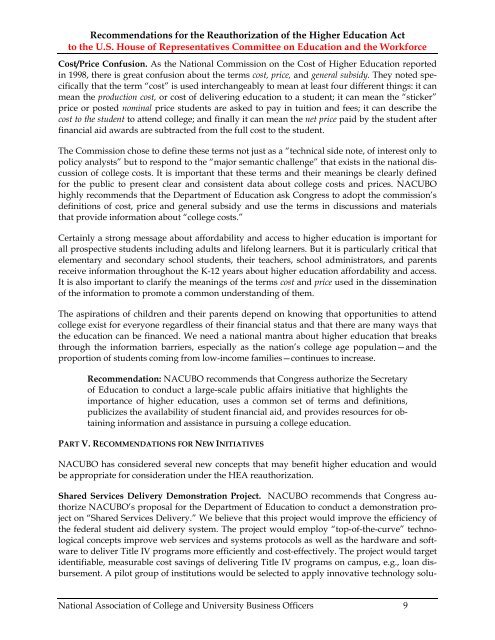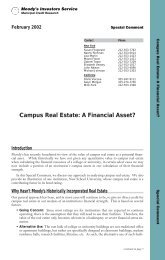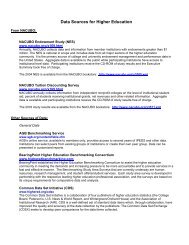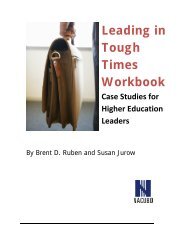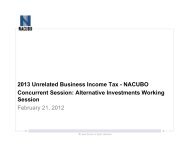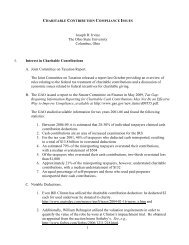March 5, 2003 The Honorable John A. Boehner U.S. ... - NACUBO
March 5, 2003 The Honorable John A. Boehner U.S. ... - NACUBO
March 5, 2003 The Honorable John A. Boehner U.S. ... - NACUBO
Create successful ePaper yourself
Turn your PDF publications into a flip-book with our unique Google optimized e-Paper software.
Recommendations for the Reauthorization of the Higher Education Actto the U.S. House of Representatives Committee on Education and the WorkforceCost/Price Confusion. As the National Commission on the Cost of Higher Education reportedin 1998, there is great confusion about the terms cost, price, and general subsidy. <strong>The</strong>y noted specificallythat the term “cost” is used interchangeably to mean at least four different things: it canmean the production cost, or cost of delivering education to a student; it can mean the “sticker”price or posted nominal price students are asked to pay in tuition and fees; it can describe thecost to the student to attend college; and finally it can mean the net price paid by the student afterfinancial aid awards are subtracted from the full cost to the student.<strong>The</strong> Commission chose to define these terms not just as a “technical side note, of interest only topolicy analysts” but to respond to the “major semantic challenge” that exists in the national discussionof college costs. It is important that these terms and their meanings be clearly definedfor the public to present clear and consistent data about college costs and prices. <strong>NACUBO</strong>highly recommends that the Department of Education ask Congress to adopt the commission’sdefinitions of cost, price and general subsidy and use the terms in discussions and materialsthat provide information about “college costs.”Certainly a strong message about affordability and access to higher education is important forall prospective students including adults and lifelong learners. But it is particularly critical thatelementary and secondary school students, their teachers, school administrators, and parentsreceive information throughout the K-12 years about higher education affordability and access.It is also important to clarify the meanings of the terms cost and price used in the disseminationof the information to promote a common understanding of them.<strong>The</strong> aspirations of children and their parents depend on knowing that opportunities to attendcollege exist for everyone regardless of their financial status and that there are many ways thatthe education can be financed. We need a national mantra about higher education that breaksthrough the information barriers, especially as the nation’s college age population—and theproportion of students coming from low-income families—continues to increase.Recommendation: <strong>NACUBO</strong> recommends that Congress authorize the Secretaryof Education to conduct a large-scale public affairs initiative that highlights theimportance of higher education, uses a common set of terms and definitions,publicizes the availability of student financial aid, and provides resources for obtaininginformation and assistance in pursuing a college education.PART V. RECOMMENDATIONS FOR NEW INITIATIVES<strong>NACUBO</strong> has considered several new concepts that may benefit higher education and wouldbe appropriate for consideration under the HEA reauthorization.Shared Services Delivery Demonstration Project. <strong>NACUBO</strong> recommends that Congress authorize<strong>NACUBO</strong>’s proposal for the Department of Education to conduct a demonstration projecton “Shared Services Delivery.” We believe that this project would improve the efficiency ofthe federal student aid delivery system. <strong>The</strong> project would employ “top-of-the-curve” technologicalconcepts improve web services and systems protocols as well as the hardware and softwareto deliver Title IV programs more efficiently and cost-effectively. <strong>The</strong> project would targetidentifiable, measurable cost savings of delivering Title IV programs on campus, e.g., loan disbursement.A pilot group of institutions would be selected to apply innovative technology solu-National Association of College and University Business Officers 9


